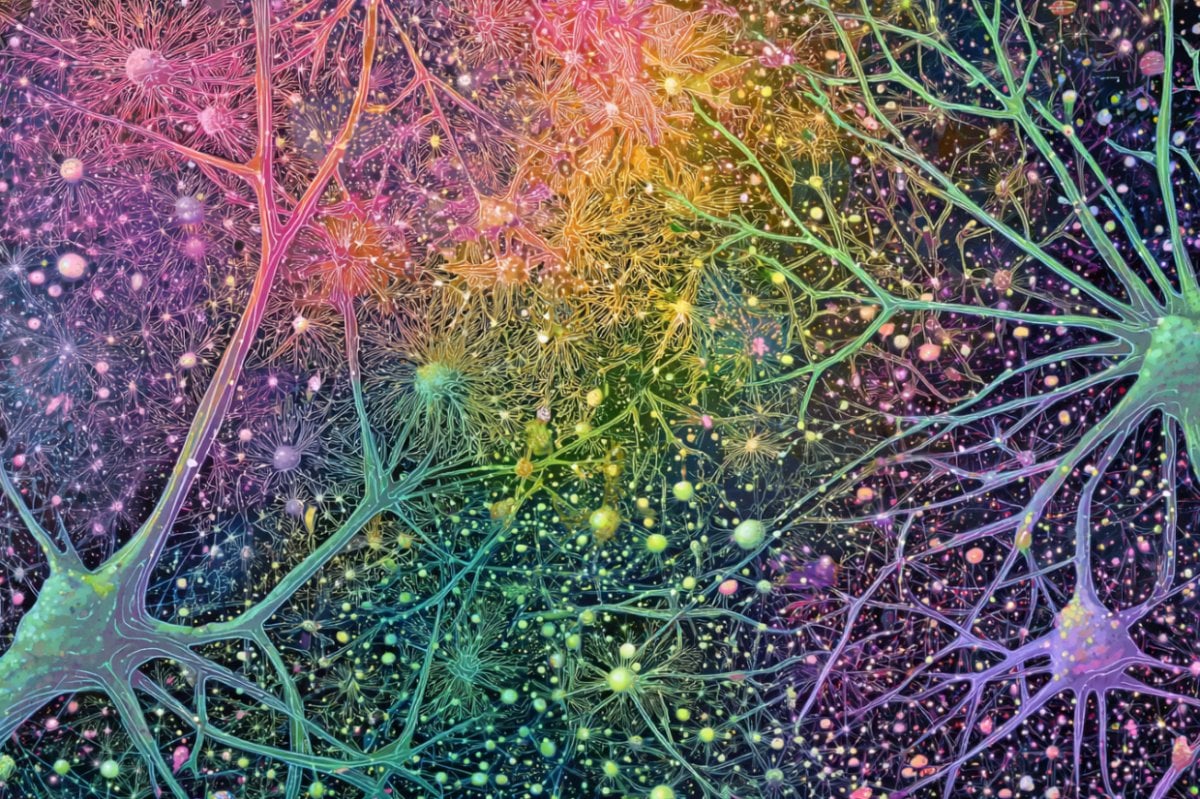Summary: Classical psychedelics like LSD, psilocybin, and mescaline are known for activating the 5-HT2A serotonin receptor, but a new study reveals their effects go far beyond. Researchers profiled 41 psychedelics against over 300 human receptors and found potent activity at serotonin, dopamine, and adrenergic sites.
The study also showed that psychedelics activate multiple intracellular pathways, which may help separate their therapeutic and hallucinogenic effects. These findings highlight the complexity of psychedelic pharmacology and open doors to more targeted therapies.
Key Facts:
- Psychedelics activate nearly every serotonin, dopamine, and adrenergic receptor.
- LSD, psilocybin, and mescaline stimulate multiple 5-HT2A receptor signaling pathways.
- Broader receptor activity may underlie both therapeutic and hallucinogenic effects.
Source: Neuroscience News
In recent years, classical psychedelics such as LSD, psilocybin, and mescaline have made a remarkable comeback—not just in popular culture, but in serious scientific research.
Once relegated to the fringes of pharmacology due to their association with counterculture movements, these compounds are now being rigorously studied for their therapeutic potential in treating mental health disorders such as depression, anxiety, post-traumatic stress disorder (PTSD), and substance use disorders.
Despite their promising clinical effects, the molecular mechanisms underlying their action in the brain have remained incompletely understood.
A new study has taken a major step toward decoding these mechanisms, offering the most comprehensive look yet at how psychedelics interact with the human brain at the receptor level. Researchers investigated the pharmacological profiles of 41 classical psychedelics—spanning tryptamines, phenethylamines, and lysergamides—against a wide panel of human receptors.
Their findings reveal a fascinating and complex picture: these compounds are far from “single-target” drugs and instead interact with dozens of neural receptors and pathways that may each contribute to their profound effects on perception, mood, and cognition.
Beyond the 5-HT2A Receptor
For decades, it’s been known that psychedelics exert their hallmark effects by activating a particular serotonin receptor, known as the 5-HT2A receptor (5-HT2AR). This receptor, distributed widely across the cortex, is thought to underlie the perceptual and cognitive distortions characteristic of a psychedelic trip. Indeed, blocking 5-HT2AR prevents many of these effects, confirming its central role.
However, the current research highlights that the story does not end there. The team profiled these psychedelics against an unprecedented 318 human G-protein-coupled receptors (GPCRs)—a vast family of receptors involved in transmitting signals from neurotransmitters and hormones.
In addition, LSD was further tested against over 450 human kinases, enzymes that regulate various cellular processes.
The results were striking: psychedelics exhibited potent and efficacious activity not only at nearly every serotonin receptor subtype, but also at a wide array of dopamine and adrenergic receptors.
This suggests that the subjective experience of psychedelics—and their potential therapeutic benefits—may emerge from the interplay of multiple receptor systems. For example, activity at dopamine receptors could help explain the mood-elevating and motivational effects sometimes reported, while adrenergic receptors may influence arousal and attention.
Mapping Psychedelic Signaling Pathways
One of the more intriguing findings from the study was that psychedelics don’t merely turn receptors “on” or “off,” but rather engage them in unique ways.
Using advanced techniques to measure how these drugs activated different intracellular signaling pathways, the researchers showed that psychedelics stimulate multiple transducers downstream of 5-HT2AR. These include pathways mediated by G proteins as well as β-arrestins—proteins that regulate receptor desensitization and signaling diversity.
What’s more, the degree to which a psychedelic activated these different pathways correlated with its potency and behavioral effects in animal models.
This points to the possibility that the therapeutic and hallucinogenic properties of psychedelics might be separable by targeting specific downstream pathways—an exciting prospect for developing “non-hallucinogenic” psychedelics that retain their antidepressant or anxiolytic effects without altering perception.
Why So Many Targets?
The fact that psychedelics act on so many different receptors raises an important question: why? One possibility is that this broad activity contributes to their unique therapeutic potential.
Mental health conditions such as depression and PTSD involve dysregulation of multiple neurotransmitter systems—serotonin, dopamine, norepinephrine—so a drug that can modulate all of them simultaneously may be more effective than one that targets only a single system.
Another intriguing idea is that the intricate receptor interactions contribute to the subjective experience of “ego dissolution” and enhanced emotional processing reported by many psychedelic users.
These experiences are thought to facilitate psychological healing by allowing individuals to confront traumatic memories or entrenched thought patterns from a new perspective.
Toward Precision Psychedelic Medicine
The findings from this research also underscore the need for a more nuanced understanding of how individual psychedelics differ. Although LSD, psilocybin, and mescaline all activate 5-HT2AR, their broader receptor profiles vary considerably, which may explain their differing durations, intensities, and therapeutic applications.
LSD, for example, is notably longer-lasting and more potent than psilocybin, which may stem from its strong binding to certain dopaminergic and adrenergic receptors in addition to 5-HT2AR.
By mapping these pharmacological fingerprints, researchers can begin to tailor specific compounds to specific conditions—or even engineer novel psychedelics that maximize therapeutic benefits while minimizing side effects.
This aligns with growing efforts to develop next-generation psychedelics that are more targeted, better tolerated, and easier to administer in clinical settings.
The Road Ahead
This landmark study provides a compelling reminder of just how complex the brain’s signaling networks are, and how much we still have to learn about how psychedelics interact with them. It also reinforces the idea that these compounds are not merely tools for altering consciousness, but also powerful probes for exploring the fundamental biology of the mind.
As clinical trials of psychedelics for depression, PTSD, and addiction continue to expand, understanding their molecular mechanisms will be key to unlocking their full potential.
By charting the diverse pathways through which they act, researchers are laying the foundation for a new era of precision psychedelic medicine—one that promises to transform how we treat some of the most challenging mental health conditions of our time.
For now, one thing is clear: psychedelics are more than just serotonin agonists. They are intricate molecular keys, unlocking a symphony of neural receptors and pathways that together orchestrate the profound changes in mood, thought, and perception we are only beginning to comprehend.
About this psychopharmacology and neuroscience research news
Author: Neuroscience News Communications
Source: Neuroscience News
Contact: Neuroscience News Communications – Neuroscience News
Image: The image is credited to Neuroscience News
Original Research: Closed access.
“The polypharmacology of psychedelics reveals multiple targets for potential therapeutics” by Manish K. Jain et al. Neuron
Abstract
The polypharmacology of psychedelics reveals multiple targets for potential therapeutics
The classical psychedelics (+)-lysergic acid diethylamide (LSD), psilocybin, and mescaline exert their psychedelic effects via activation of the 5-HT2A serotonin receptor (5-HT2AR).
Recent clinical studies have suggested that classical psychedelics may additionally have therapeutic potential for many neuropsychiatric conditions including depression, anxiety, migraine and cluster headaches, drug abuse, and post-traumatic stress disorder.
In this study, we investigated the pharmacology of 41 classical psychedelics from the tryptamine, phenethylamine, and lysergamide chemical classes.
We profiled these compounds against 318 human G-protein-coupled receptors (GPCRs) to elucidate their target profiles, and in the case of LSD, against more than 450 human kinases.
We found that psychedelics have potent and efficacious actions at nearly every serotonin, dopamine, and adrenergic receptor.
We quantified their activation for multiple transducers and found that psychedelics stimulate multiple 5-HT2AR transducers, each of which correlates with psychedelic drug-like actions in vivo.
Our results suggest that multiple molecular targets likely contribute to the actions of psychedelics.







